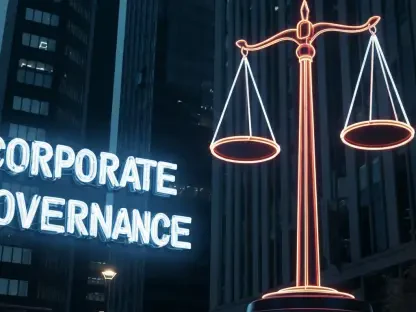Setting the Stage for a Regulatory Shift
The global financial landscape is undergoing a profound transformation as the United States Financial Crimes Enforcement Network (FinCEN) intensifies its battle against money laundering tied to illicit opioid trafficking, marking a critical turning point in regulatory oversight. On June 25, 2025, FinCEN designated three Mexican financial institutions—CIBanco, Intercam Banco, and Vector Casa de Bolsa—as primary money-laundering concerns, marking a pivotal moment in anti-money laundering (AML) enforcement. This action, rooted in the authority of key legislation, underscores a stark reality: the intersection of drug trafficking and financial systems poses a critical threat to international security. The designations block these entities from US financial transactions, sending ripples through the industry and raising pressing questions about compliance readiness across borders.
This move is not merely a regional concern but a signal of a broader crackdown that could reshape how financial institutions operate worldwide. The implications stretch beyond immediate penalties, challenging banks to reassess their risk profiles and fortify defenses against illicit finance. As enforcement strategies evolve, the industry faces a defining moment where adaptation is no longer optional but essential for survival in an increasingly scrutinized environment.
The New Era of Anti-Money Laundering Enforcement
FinCEN’s recent designations of the three Mexican institutions highlight a bold step in combating money laundering linked to fentanyl trafficking. Under the Fentanyl Sanctions Act of 2019 and the FEND Off Fentanyl Act of 2024, these actions sever the targeted banks from the US financial system, prohibiting any fund transfers involving their accounts. This marks a significant escalation in efforts to disrupt the financial networks fueling the opioid crisis, with a clear focus on curbing cartel operations.
The broader impact of these measures reverberates through international finance, as they redefine risk assessments and compliance expectations. Financial institutions now face heightened scrutiny, with the potential for similar designations looming over entities in other regions. This shift signals a departure from traditional enforcement, emphasizing rapid, decisive action to isolate complicit organizations from global markets.
Moreover, the designations reflect a seismic change in regulatory strategy, leveraging legislative tools to address national security threats posed by drug trafficking. The blocking of transactions not only isolates the named institutions but also serves as a warning to others, pushing the industry toward stronger safeguards. As FinCEN sets this precedent, the global financial system must recalibrate to navigate an era of uncompromising enforcement.
Historical Context and Evolution of AML Strategies
From Bank Secrecy Act to Fentanyl-Specific Legislation
The journey of US AML enforcement began with the Bank Secrecy Act of 1970, establishing foundational requirements for financial institutions to report suspicious activities. This framework evolved significantly with the USA PATRIOT Act of 2001, which expanded FinCEN’s authority through Section 311 designations, enabling the agency to target foreign entities as money-laundering concerns. These tools have proven instrumental in disrupting illicit finance over decades, setting the stage for more targeted measures.
Legislation specifically addressing fentanyl trafficking emerged with the Fentanyl Sanctions Act of 2019, followed by the FEND Off Fentanyl Act of 2024, which introduced immediate prohibitions on fund transfers for designated entities. These laws reflect a recognition of opioid trafficking as a dire threat, equipping regulators with mechanisms to act swiftly. The progression from broad AML policies to drug-specific sanctions illustrates a sharpening focus on emerging risks.
Key milestones, such as past Section 311 actions against foreign banks, demonstrate the profound economic impact of such designations, often leading to institutional collapse or market disruptions. This historical backdrop underscores the gravity of current actions against Mexican banks, positioning them as part of a long-standing, yet evolving, strategy to safeguard financial integrity. The trajectory suggests an ongoing refinement of tools to address complex, transnational challenges.
Integration of Counterterrorism and AML Tools
A groundbreaking development in AML enforcement is the integration with counterterrorism frameworks, exemplified by the State Department’s 2025 designation of Mexican cartels as Foreign Terrorist Organizations (FTOs). This classification elevates cartel activities to the level of terrorism financing under US law, aligning drug trafficking with threats traditionally associated with extremist groups. The fusion of these authorities amplifies the regulatory impact on financial institutions linked to such entities.
This strategic alignment transforms the legal consequences for banks facilitating cartel operations, shifting the narrative from criminal oversight to national security imperatives. By treating cartel support as material aid to terrorism, US regulators wield a potent mechanism to deter and punish complicity. The approach marks a significant departure from conventional AML practices, broadening the scope of accountability.
The combined use of AML and counterterrorism tools creates a robust enforcement model, capable of addressing hybrid threats that span crime and security domains. Financial institutions must now contend with dual layers of scrutiny, navigating a landscape where regulatory expectations intersect with geopolitical priorities. This integration sets a precedent for future actions, potentially reshaping global compliance standards.
Specific Allegations and Systemic Failures in Mexican Banks
FinCEN’s allegations against CIBanco, Intercam Banco, and Vector detail severe lapses in AML controls, directly implicating them in cartel-related money laundering. CIBanco is accused of enabling an employee to launder millions for a cartel operative, alongside processing payments for fentanyl precursors. Similarly, Intercam Banco and Vector are cited for facilitating illicit transactions, with deficiencies in oversight spanning years, pointing to entrenched vulnerabilities.
These issues are not isolated incidents but indicative of systemic failures, as evidenced by FinCEN’s analysis of over $1 billion in suspicious activity reports tied to Mexican financial institutions. The reports highlight consistent shortcomings in customer due diligence and transaction monitoring, allowing illicit flows to persist undetected. Such widespread gaps expose the fragility of existing compliance structures in the region.
The enforcement effort extends beyond FinCEN, involving coordinated actions with the Department of Justice and the Office of Foreign Assets Control. This interagency collaboration enhances the impact of designations, coupling financial restrictions with asset freezes and whistleblower incentives. The unified approach underscores a comprehensive strategy to dismantle the financial underpinnings of cartel operations, pressing institutions to address systemic risks head-on.
Regulatory Implications and Compliance Challenges
The regulatory fallout from FinCEN’s actions imposes immediate restrictions, including asset freezes and prohibitions on fund transfers for the designated Mexican banks. These measures, reinforced by Specially Designated Nationals listings, isolate the entities from the US financial system, creating a ripple effect on their global operations. The severity of these penalties sets a high bar for compliance across the industry.
Mexican and international banks now face significant challenges in aligning with US expectations and Financial Action Task Force standards. Discrepancies in local oversight, such as Mexico’s regulatory fines that appear reactive rather than preventive, highlight gaps in enforcement effectiveness. This inconsistency complicates efforts to harmonize practices with stringent global requirements, exposing institutions to heightened risk.
Addressing these challenges requires a fundamental overhaul of compliance frameworks to prevent systemic AML failures. Financial entities must navigate a complex landscape where US dominance in global finance dictates rigorous standards, often outpacing local capabilities. The urgency to adapt is clear, as failure to meet these benchmarks could result in similar punitive actions, threatening operational viability.
Strategic Actions for Financial Institutions
To mitigate risks in this heightened regulatory environment, financial institutions must prioritize robust governance by establishing dedicated AML and counter-terrorist financing subcommittees. Boards should ensure regular oversight and demand accountability from compliance officers to fortify internal controls. Such structural enhancements are critical to preempting violations that could attract FinCEN’s attention.
Investment in advanced transaction-monitoring technologies is equally vital, enabling real-time detection of suspicious activities, particularly in high-risk jurisdictions. Enhanced due diligence for cross-border clients, coupled with rigorous know-your-customer protocols, can further shield institutions from illicit entanglements. These proactive measures are essential to maintaining integrity in an era of intensified scrutiny.
Beyond technical solutions, fostering a culture of compliance from the top down remains paramount. Boards must integrate AML priorities into corporate strategy, monitor geopolitical risks such as trade tensions, and prepare crisis management plans for potential fallout. Aligning with global standards and adapting to evolving threats will position institutions to withstand regulatory pressures and safeguard their future.
Future Outlook and Global Implications
Looking ahead, FinCEN’s enforcement trajectory may extend to fentanyl precursor hubs in regions like India and Vietnam, targeting supply chain vulnerabilities. The framework established with Mexican banks could also apply to cyber-enabled laundering networks, addressing modern financial crime tactics. This expansion signals a broader application of regulatory tools to tackle diverse illicit activities.
The fusion of AML expertise with counterterrorism mechanisms sets a new enforcement paradigm, potentially addressing hybrid threats and state-sponsored illicit finance. Financial institutions worldwide must anticipate these developments, recognizing that regulatory focus will likely intensify across multiple domains. Staying ahead of such trends requires vigilance and strategic foresight.
Adaptation is the cornerstone of survival in this transformed landscape, as global banks face pressure to implement proactive measures. The industry must brace for a future where enforcement actions become more frequent and far-reaching, reshaping compliance priorities. Preparing for these shifts now will determine resilience in the face of evolving regulatory challenges.
Reflecting on a Transformative Era
The designations of CIBanco, Intercam Banco, and Vector by FinCEN, coupled with the Foreign Terrorist Organization classification of Mexican cartels, redefined the boundaries of global AML enforcement in 2025. This unprecedented convergence of financial and counterterrorism tools marked a turning point, compelling the industry to confront the intertwined threats of drug trafficking and illicit finance. The actions underscored the urgency for systemic change, leaving an indelible impact on regulatory expectations.
Looking back, the coordinated interagency efforts amplified the effectiveness of these measures, setting a high standard for accountability. Financial institutions grappled with the immediate consequences of asset freezes and transaction bans, while the broader implications reshaped risk management approaches. The period highlighted the critical need for alignment with international standards to avoid similar repercussions.
As a path forward emerged, the focus shifted to actionable strategies for resilience. Institutions were urged to invest in cutting-edge technologies, prioritize governance reforms, and cultivate a proactive compliance mindset to navigate future uncertainties. Building partnerships with regulators and leveraging geopolitical insights became essential steps to fortify defenses, ensuring that the lessons of this era guided sustainable progress in safeguarding financial integrity.









